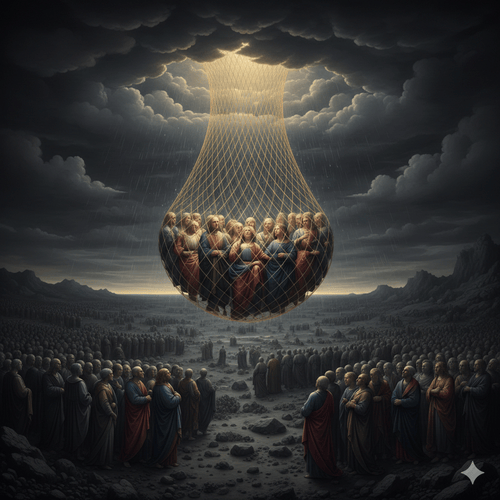The Golden Ratio in Nature: A Powerful Challenge To Materialism
In the swirl of a nautilus shell, the arrangement of sunflower seeds, and the spiral arms of galaxies lies a mathematical constant so precise and prevalent that it challenges our understanding of random evolution. This mathematical relationship—the Golden Ratio (approximately 1.618)—appears with such regularity throughout nature that it raises profound questions about the origin and structure of our universe—questions that materialism cannot adequately answer…
Understanding the Golden Ratio
The Golden Ratio, denoted by the Greek letter φ (phi), appears when you divide a line into two parts. Now, consider this: the length of the longer part divided by that of the shorter part gives you the same number as the length of the whole line divided by the longer part. This magic number is always approximately 1.618.
For instance, if the shorter part of a line is 1 unit long, and the longer part is 1.618 units long, the whole line would be 2.618 units long. When we divide the longer part (1.618) by the shorter part (1), we get 1.618. And when we divide the whole line (2.618) by the longer part (1.618), we also get 1.618.
This perfect mathematical harmony appears throughout nature, from the spirals of galaxies to the petals of a flower. Throughout history, this divine proportion has captivated minds across cultures. Ancient Greeks, recognising its special properties, incorporated it into their architecture and art. And Renaissance masters used it to create masterpieces that still inspire awe today.
The Golden Ratio in Nature
- The Plant Kingdom: Nature’s mathematical precision becomes strikingly evident in plant life. The arrangement of leaves around a stem, known as phyllotaxis, follows the Golden Ratio to ensure optimal sunlight exposure. Sunflowers display an astounding array of spirals in their seed heads, following Fibonacci numbers (closely related to the Golden Ratio) with clockwork precision. Pine cones, pineapples, and other plant structures exhibit the same mathematical patterns, suggesting an underlying design principle.
- The Animal Kingdom: The nautilus shell’s logarithmic spiral precisely follows the Golden Ratio, creating a growth pattern that maintains the same perfect proportions throughout the creature’s life. This mathematical precision extends to the proportions of various animal body parts, from the segments of insects to the dimensions of dolphin bodies. Perhaps most remarkably, the DNA molecule itself exhibits Golden Ratio proportions in its structure.
- The Cosmic Scale: Ascending to the cosmic scale, we find the Golden Ratio governing the proportions of planetary orbits and the spiral arms of galaxies. Weather patterns, including the proportions of air pressure spirals in hurricanes, often conform to this ratio. The universality of this pattern across vastly different scales suggests a fundamental principle of design in the universe.
The Mathematical Improbability
The presence of the Golden Ratio across such diverse systems presents a significant challenge to materialistic explanations. The probability of this precise mathematical relationship appearing randomly across multiple unrelated systems defies statistical explanation. The simultaneous emergence of this ratio in biological, physical, and cosmic systems suggests an underlying design principle rather than random processes.
Consider the precision required: the ratio must be maintained to multiple decimal places for these systems to function optimally. The likelihood of such precision arising through random mutations and natural selection stretches credibility to its breaking point.
The Materialist Dilemma
Current evolutionary theory struggles to explain the consistent appearance of the Golden Ratio across diverse systems. While natural selection can account for the preservation of beneficial traits, it fails to explain why this specific mathematical relationship appears so frequently. The precision and universality of the Golden Ratio pose particular challenges to materialistic explanations.
The fundamental question remains: how could random processes produce such mathematical precision across different scales and systems? The materialist worldview lacks a compelling explanation for this level of mathematical harmony in nature.
The Case for Design
- Intelligent Design Perspective: The ubiquity of the Golden Ratio suggests a universe fine-tuned by an intelligent designer. The presence of this mathematical constant across various scales and systems points to a unified design principle. The combination of beauty and functionality in these proportions suggests purpose rather than chance.
- Biblical Connection: Ancient awareness of divine proportions is reflected in historical architecture and religious texts. The dimensions of sacred structures, from the Ark of the Covenant to Solomon’s Temple, often incorporate these divine proportions. This ancient knowledge of mathematical harmony suggests an understanding of fundamental design principles in creation.
The Golden Ratio in Nature—Implications and Conclusions
The Golden Ratio’s ubiquitous presence in nature points to a deeper reality than materialistic evolution can explain. Its precision and universality suggest a designed universe rather than one of random chance. This mathematical harmony invites us to consider the existence of a divine mathematician, an intelligent designer who embedded these principles into the fabric of creation.
As we continue to discover the Golden Ratio in new places, from quantum mechanics to cosmic structures, the evidence for design grows stronger. These discoveries challenge us to look beyond materialistic explanations and consider the possibility of a universe crafted with purpose and mathematical precision.
The Golden Ratio is a testimony to order in the universe—not the chaos of random processes, but the harmony of intelligent design. It invites us to wonder at the mind behind the mathematics and to recognise the fingerprints of the Creator in the elegant equations that govern our world.
Addressing Materialist Objections—Related FAQs
The Coincidence and Pareidolia Argument: Isn’t the appearance of the Golden Ratio mere coincidence—a result of the typical human tendency to see patterns (pareidolia) everywhere? While we do tend to see patterns, the mathematical precision of the Golden Ratio in nature far exceeds mere pattern recognition. The fact that this specific ratio (1.618…) appears repeatedly in completely unrelated systems—from quantum physics to galaxy formations, from DNA structures to hurricane patterns—with mathematical exactitude suggests deliberate design rather than coincidence. The statistical probability of the same precise mathematical constant appearing randomly across such diverse systems is astronomically low—it’s rather like expecting to win multiple lotteries simultaneously.
- The Argument from Mathematical Necessity: Don’t these patterns simply arise from mathematical necessity in growth processes? While growth processes do follow mathematical patterns, this doesn’t explain why they consistently follow this specific ratio rather than countless other possible mathematical relationships. The Golden Ratio represents optimal efficiency, beauty, and functionality simultaneously—a hallmark of intelligent design rather than blind mathematical necessity. Moreover, the same ratio appears in static structures and non-growth-related phenomena (like planetary orbits): how would you explain this by growth processes alone? Other mathematical constants, like Pi or Euler’s number, do not exhibit the same ubiquity across biological and non-biological contexts.
The Argument from Natural Selection: Can’t natural selection explain the prevalence of Golden Ratio patterns? Natural selection can only select from existing variations—it cannot explain the origin of the mathematical precision itself. For natural selection to favour Golden Ratio patterns, these patterns would need to arise randomly first, and the probability of such precise mathematical relationships arising by chance is virtually impossible. Furthermore, the appearance of the Golden Ratio in non-biological systems (such as galaxies and weather patterns) cannot be explained by natural selection, underscoring the need for a different explanatory framework.
- The Argument from Confirmation Bias: Aren’t we just cherry-picking examples and ignoring cases where the Golden Ratio doesn’t appear? While not everything in nature follows the Golden Ratio, its appearance in fundamental systems crucial for life and cosmic order is undeniable and mathematically verifiable. The ratio’s presence in key biological structures (DNA, cell membranes), optimal growth patterns, and cosmic structures suggests it’s a foundational design principle rather than selective observation. The fact that it appears in critical rather than random systems makes it even more compelling as evidence of design. Multiple independent studies have confirmed these patterns, reducing the likelihood of confirmation bias.
The Argument from Cultural Influence: Isn’t the Golden Ratio’s importance just a cultural phenomenon rather than divine inspiration? Ancient civilisations across continents and time periods discovered and utilised this ratio independently, suggesting its significance transcends cultural boundaries. While culture has certainly celebrated this ratio, its objective mathematical properties and natural occurrence existed long before human recognition. The ratio’s presence in structures such as galaxies and atomic formations predates human culture entirely, indicating a universal principle rather than a cultural construct.
- The Argument from Scientific Naturalism: Shouldn’t we stick to purely naturalistic explanations for mathematical patterns? Scientific naturalism itself cannot explain why the universe follows mathematical laws and patterns at all—this is known as the “unreasonable effectiveness of mathematics” problem noted by physicist Eugene Wigner. The presence of precise mathematical order suggests a rational, mathematical mind behind the universe. The Golden Ratio’s combination of beauty, efficiency, and functionality points to purposeful design rather than blind natural processes. Naturalism often fails to address the deeper question of why these laws exist in the first place.
The ‘Where’s the Evidence?’ Argument: Where’s the direct evidence linking the Golden Ratio to a creator? The evidence lies in the ratio’s unique properties that combine mathematical precision, aesthetic beauty, and functional optimisation—characteristics that point to intelligent design. Consider this: even our best human designs rarely achieve such elegant mathematical harmony, yet this ratio appears consistently throughout creation. The sheer improbability of such precise mathematical relationships arising randomly, combined with their universal presence, strongly suggests a divine mathematician at work. Just as we infer an intelligent designer behind complex human-made structures, the pervasive occurrence of the Golden Ratio points to a higher, purposeful order in nature.
The Golden Ratio in Nature—Our Related Posts
- The Argument From Beauty: Five Reasons To Believe It Points To Design
- Patterns In Chaos: How Fractals Scream Intelligent Design
- Quantum Entanglement: The Hidden Code That Points to God’s Design
- The Mandelbrot Set: Surprising Evidence for Intelligent Design
- Sacred Symmetry: How Fibonacci Numbers Reveal God’s Design
Editor's Pick

Why Do People Hate the Doctrine of Election?
…WHEN THEY REALLY SHOULDN’T Few Bible doctrines provoke stronger reactions than election. The idea that God chose some for salvation [...]

The Doctrine of Providence: Does God Really Govern All Things?
You’re sitting in the doctor’s office when the diagnosis lands like a thunderclap. Your mind races: Why this? Why now? [...]

No Decay, No Defeat: What It Means That Christ’s Body Saw No Corruption
On the Day of Pentecost, Peter stood before thousands and made a startling claim: David's body decayed in the tomb, [...]
SUPPORT US:
Feel the Holy Spirit's gentle nudge to partner with us?
Donate Online:
Account Name: TRUTHS TO DIE FOR FOUNDATION
Account Number: 10243565459
Bank IFSC: IDFB0043391
Bank Name: IDFC FIRST BANK






